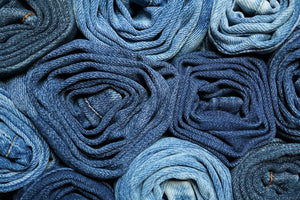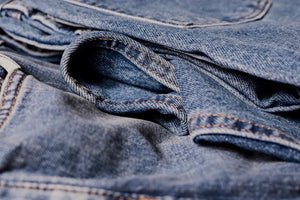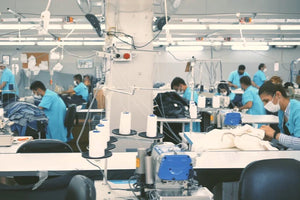These 5 materials are which Torland’s clothing is made of
Jun 22, 2023
Organic cotton, elastane, wool, Tencel and recycled polyester are used in the production of TORLAND clothing. When selecting the fabrics for our organic jeans and basic clothing, we pay particular attention to the sustainable aspect. The textiles should be made of natural fibers or recycled materials wherever possible, last a long time and be comfortable to wear. In this article, we introduce the five materials, explain their differences as well as advantages and disadvantages and first explain what distinguishes natural from synthetic fabrics.
WHAT DIFFERS NATURAL FROM SYNTHETIC SUBSTANCES
Natural fabrics in the clothing industry are derived from plant or animal sources, such as cotton, wool or silk. They are biodegradable, breathable and generally skin-friendly. Synthetic fabrics, on the other hand, are made from chemically produced fibers such as polyester or nylon. This makes them durable, wrinkle-free and they dry quickly. However, synthetic fabrics have less breathability and can release microplastic particles. The main difference lies in the origin and properties of the fibers and the ecological impact, although in general, natural fabrics tend to be more sustainable.
The five materials used are described below. The first three are natural materials, while the last two are synthetic.
ORGANIC COTTON
Organic cotton is a type of cotton that is grown according to ecological standards. No genetically modified organisms, chemical pesticides or synthetic fertilizers are used in the production of organic cotton. Instead, natural methods are used to repel pests and keep the soil fertile.
The benefits of organic cotton are its environmental friendliness and lower risk to the health of farmers and consumers. Growing organic cotton helps maintain soil health, promotes biodiversity and reduces water pollution. Organic cotton is also hypoallergenic and can be beneficial for people with sensitive skin.
From an environmental perspective , organic cotton offers a more sustainable alternative to conventional cotton . It reduces the use of chemicals and minimizes the impact on soil, water and air. In addition, growing organic cotton supports fairer working conditions and fairer wages for farmers.
However, organic cotton also has some disadvantages. It usually requires more land to grow compared to conventional cotton, which can lead to lower productivity. In addition, organic cotton products are often more expensive because production costs are higher.
Overall, organic cotton is a more environmentally friendly option for producing clothing that promotes human and environmental health. By purchasing products made from organic cotton, consumers can actively contribute to supporting sustainability in the textile industry and reducing the use of harmful chemicals . These are also the reasons why we only use organic cotton for our TORLAND jeans.
You can find more information about organic cotton here .
WOOL
Wool is a natural fiber obtained from sheep and other animals such as angora goats and cashmere goats. It is known for its thermal insulation , softness and breathability . Wool is used in the textile industry for a variety of garments such as sweaters, scarves and socks.
The benefits of wool for clothing are its natural thermal insulation, which provides comfort in cold weather. It can absorb and release moisture, which helps regulate body temperature. Wool is also naturally stain and odor resistant and has a high level of durability.
From an environmental perspective, wool offers several advantages. It is a renewable resource and has a lower environmental impact compared to synthetic fibers. Growing wool can also help improve soil health and reduce the use of chemical fertilizers. In addition , wool is biodegradable and therefore leaves no permanent waste when disposed of.
However, there are some disadvantages to using wool. Production requires water and land, and there may be concerns about animal welfare and the use of pesticides and insecticides. In addition, wool can cause allergic reactions in sensitive individuals.
However, there are efforts to improve sustainability in the wool industry , for example by promoting animal-friendly practices and environmentally friendly standards.
Overall, wool is a natural fiber with many positive properties for clothing. By using wool responsibly, supporting sustainable practices and choosing certified wool, consumers can help minimize the environmental impact and promote animal welfare.
TENCEL
Tencel, also known as Lyocell , is a natural fiber derived from wood pulp. It is produced using an environmentally friendly manufacturing process based on a closed loop that recycles solvents. Tencel is characterized by its softness, breathability and its ability to absorb and release moisture effectively.
The benefits of Tencel for clothing are its sustainability and environmental friendliness . The production of Tencel requires less water and energy compared to other fibers. The closed-loop process minimizes the use of chemicals and reduces the environmental impact. Tencel is also biodegradable and therefore leaves no permanent waste.
From an ecological point of view, Tencel offers a more sustainable alternative to conventional fibers. The cultivation of wood for Tencel production can be done sustainably, for example by using wood from sustainably managed forests. Tencel is also suitable for people with sensitive skin , as it is hypoallergenic and soft.
However, there are some potential drawbacks to using Tencel. The main ingredient, wood, comes from trees that must be cut down, and there may be concerns about deforestation and the environmental footprint. Additionally, commercial production of Tencel is still relatively new, which may present challenges with availability and price.
Overall, Tencel is a promising eco-friendly fiber for clothing production. By consciously purchasing clothing made from Tencel and supporting sustainable production practices, consumers can help reduce the environmental impact of the textile industry and promote a more sustainable future.
RECYCLED POLYESTER
Polyester is a synthetic fiber made from petroleum-based chemicals. It is characterized by its high strength, durability and wrinkle resistance. Polyester has low water absorption, dries quickly and holds its shape well.
Advantages of polyester for clothing include its durability, colorfastness and the ability to produce it in different textures. It is also easy to care for and can be machine washed.
However, from an environmental perspective, polyester has some disadvantages. Manufacturing requires fossil fuels and chemical processes that can contribute to pollution . Polyester is not biodegradable and can therefore become a burden on landfills and oceans when garments are disposed of. In addition, polyester can release microplastic particles when washed, which can have negative impacts on waterways. We recommend placing clothes in a laundry bag for washing or loading the washing machine to capacity.
At TORLAND, we therefore only use recycled polyester to minimise our impact on the environment and reduce the need for new raw material. It is important to use, recycle and dispose of polyester garments responsibly to protect the environment.
ELASTAN
No skinny jeans without elastane! Elastane, also known as spandex or lycra , is a synthetic fiber known for its high elasticity and stretchability. It is often used in blends with other fibers to make textiles elastic.
The advantages of elastane lie in its exceptional stretchability and resilience. This allows for a good fit and freedom of movement in clothing such as sportswear, swimsuits, underwear and stretch jeans. Elastane retains its shape even after repeated stretching and offers long-lasting comfort. Just 1 or 2 percent of the total fabric is enough to give a pair of jeans a pleasant stretch feeling.
From an environmental perspective, elastane has similar challenges to polyester. Its production requires fossil fuels and chemical processes. Elastane is not biodegradable and can therefore cause environmental pollution if not disposed of properly. In addition, elastane can also release microplastic particles when washed in the washing machine.

SUMMARY: NATURAL VERSUS SYNTHETIC
Both natural and synthetic fibers have both advantages and disadvantages in the clothing industry. Natural fibers such as organic cotton, wool and Tencel offer advantages such as environmental friendliness, breathability and skin compatibility. They help reduce the use of harmful chemicals and support sustainable farming practices. However, they can also be associated with higher costs and require more resources.
On the other hand , synthetic fibers such as polyester and elastane offer advantages such as durability, wrinkle resistance and stretchability. They are often more cost-effective and can offer specific functional properties. However, they come with environmental burdens such as the use of fossil fuels, the release of microplastic particles and lower breathability.
CONCLUSIONChoosing the right material for clothing requires a balance between the various pros and cons. It is about considering the impact on the environment, people's health and wellbeing . A conscious choice for sustainable alternatives such as organic cotton, recycled polyester and Tencel can make a positive contribution to reducing the fashion industry's environmental footprint. At the same time, it is important to use, recycle and dispose of garments made from synthetic fibres responsibly to reduce environmental impact. Ultimately, it is our responsibility as consumers to consider the impact of our purchasing decisions on the environment and the people in the textile industry and to support sustainable fashion options.
Original sound, Sascha Hümbeli (founder of TORLAND): "The use of sustainable materials has been a matter of course for me as a trained environmental scientist and designer of TORLAND jeans from the very beginning. Only on this basis was it possible for me to create the first sustainable jeans models, even if in the initial phase the selection of organic cotton fabrics was still very limited and therefore expensive. A lot has changed in the meantime and both quality and selection have improved greatly and can now keep pace with conventional materials."




